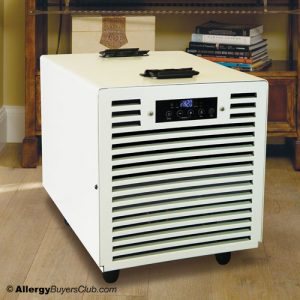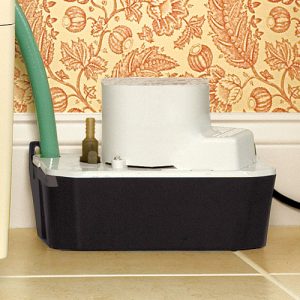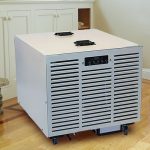Dehumidifier Guide
- What does a dehumidifier do?
- What size dehumidifier do I need?
- What does 30 pint, 50 pint, or 65 pint dehumidifiers mean?
- What will happen if I buy too large a dehumidifier?
- What happens if I buy too small a unit?
- If I buy too small of a unit won’t it still make the room feel more comfortable?
- What is a low temperature dehumidifier?
- What humidity level should I keep the room?
- What happens if I try to keep the room at 40% or 35%?
- Why can’t you lower the humidity to zero or 5 to 10 percent with a dehumidifier?
- Why does my dehumidifier remove significant amounts of moisture the first 1 to 2 days and then slows down?
- How much will it cost to run?
- Why do dehumidifiers use so much electricity?
- Why are most dehumidifiers so noisy?
- Can I have windows open while I dehumidify?
What does a dehumidifier do?
Simply, it removes moisture from the air, floor, walls, or any materials in the room including your personal belongings by drawing air into the dehumidifier with its fan and cooling it so it can release the moisture in the form of water droplets.
What size dehumidifier do I need?
Size of a dehumidifier is not the actual size of the unit, it refers to how much dehumidifying capacity of the dehumidifier. on the level of humidity in the space you are trying to dehumidify, it is super damp? Or only mildly damp?
In general this sizing Rule of Thumb for most areas is:
All of these figures are based on an 8’ high ceiling. So if the height is 10’, then add 25% more to the square footage and if 12’ high, then add 50%, etc.
| Square Feet Maximum | Dehumidifier Pint Size |
| 400 square feet | 25 pint |
| 500 square feet | 30 pint |
| 800 square feet | 40 pint |
| 1000 square feet | 50 pint |
| 1300 square feet | 65 pint |
| 1400 square feet | 70 pint |
| 2200 square feet | 90 pint |
| 2500 square feet | 105 pints |
What does 30 pint, 50 pint, or 65 pint dehumidifiers mean?
That number tells you approximately how many pints of water it can remove in 24 hours. It has nothing to do with the size of the collection bucket.
What if I buy too large a dehumidifier?
The unit will not need to run as long as necessary to reach your desired humidity level. However, if this larger dehumidifier uses a much greater amount of electricity than a smaller unit one may find they are still using more even though it is running less. In addition, a good deal of electricity is used when a compressor starts up so this larger compressor will add to the overall electrical expense.
What happens if I buy too small a dehumidifier?
The unit will operate continuously and you may find it is not able to reduce the humidity to the desired level.
If I buy too small of a dehumidifier won’t it still make the room feel more comfortable?
Yes, but it may not reach as comfortable a level as one more appropriately sized. Furthermore, if it cannot reach and maintain humidity levels below 55% mold development would still be a danger.
What is a low temperature dehumidifier?

It is designed to be able to operate at temperatures below 65 degrees. If the temperature drops below 65 degrees, the water can freeze on the evaporator coils in the dehumidifier at which continued build-up of ice could result in an interference with the air-flow and possibly fan motor burnout. A low temperature dehumidifier will prevent ice build-up by using an intermittent defrost cycle, which will shut the compressor off when the coils become too cold. Once the coils warm up a bit the compressor can come on to resume dehumidifying.
What humidity level should I keep the room?
We recommend 50% since mold will not start to grow until humidity levels go above 55%. Furthermore, unless you need it less to protect a particular belonging you would be wasting electricity since it would need to operate for longer periods of time to maintain the lower setting. For example, a recommended humidity level for a piano is 45%.
What happens if I try to keep the room at 40% or 35%?
You will be wasting money on electricity. And you usually cannot dehumidify much below 40%. You will have to weigh the expense of extended operating times with your comfort level.
Why can’t you lower the humidity to zero or 5 to 10 percent with a dehumidifier?
A dehumidifier uses a refrigerant system to cool the incoming air low enough so it releases its moisture onto the surface of the evaporator coils called dew point. A good example of this is whether or not there is dew or frost on your lawn in the morning. If the air temperature does not drop low enough to reach the dew point of the air no dew or frost will be released from the air onto the grass. The dew point of the air depends on the temperature and the humidity. The dew point temperature will decrease with a correlating decrease in both the temperature and the humidity. Therefore, if the lowest the dehumidifier is able to cool the incoming air is 35 to 45 degrees and the dew point is lower than this than no dehumidification can occur. In other words, the present conditions will not allow any more moisture to be removed from the air. So, if the present air temperature in the room is 50 degrees and the humidity is 50% this represents a dew point of 32 degrees so there will no longer be any moisture removed from the air until the air temperature and/or humidity increase to raise the dew point to 35 to 45 degrees.
How often will I have to empty the bucket?
It depends on the size of the area you are dehumidifying and the desired humidity level you want to maintain as well as the size of the bucket
Does that mean that if I have a 65 pint unit with a 20 pint water bucket, that I will have to empty it more than once a day?
Yes, if the area you are dehumidifying is large enough and/or conditions are humid.
What other options are there if I do not wish to empty the bucket?
 There are two other options: one is to connect a hose to the opening so the water that is removed can drain out continuously into a floor drain. Most of the models available today provide such a feature but do not always provide the hose. The second method is to set the end of the hose you are using from the first option into the reservoir of an external pump. When it is full the pump will turn on and push the water out a discharge hose to a location such as the upstairs, up and out a window, or into a sink. Some pumps come with the hose and some do not. Also, there are some dehumidifiers that come with a built in pump.
There are two other options: one is to connect a hose to the opening so the water that is removed can drain out continuously into a floor drain. Most of the models available today provide such a feature but do not always provide the hose. The second method is to set the end of the hose you are using from the first option into the reservoir of an external pump. When it is full the pump will turn on and push the water out a discharge hose to a location such as the upstairs, up and out a window, or into a sink. Some pumps come with the hose and some do not. Also, there are some dehumidifiers that come with a built in pump.
Can the dehumidifier bucket overflow?
No. Every unit has a float switch to shut off the unit when the water rises to a certain level.
Why does my dehumidifier remove significant amounts of moisture the first 1 to 2 days and then slows down?
Initially, you are not only dehumidifying the moisture in the air but what is in floor, walls, ceiling, plus the materials in the room. Once the humidity in the air decreases to a certain level the moisture in the floor, walls, ceiling, and materials in the room will start to release their moisture into the air and dry out. This will increase the amount of moisture in the air and create a secondary load on the dehumidifier until everything has dried out. Once all of this is done the dehumidifier will only need to maintain the humidity so there will be less moisture in the air to pull out.
How much will it cost to run?
We can’t tell you. It depends on how much moisture you need to remove and how long it needs to run to achieve your desired level? Furthermore, everyone’s kilowatt hour rate varies throughout the country as well as other variables like taxes, delivery fees, and surcharges levied by particular power companies.
Why do dehumidifiers use so much electricity?
The reason is due to the power required to circulate and compress the refrigerant which is done with the compressor. It can use 5 to 10 times more electricity than what is generated by the fan in the dehumidifier.
Why are most dehumidifiers so noisy?
The reason is that there is not only noise generated by a fan but in some cases of a greater nature from the compressor. Normally, with most fans there will be a consistent noise pitch and decibel level. However, with certain compressors there can be a modulating noise in pitch that can be more intolerable than from the fan.
Can I have windows open while I dehumidify?
No, or you will be trying to dry the air outside of your house. It would be the same thing as leaving your windows open while you are running your air conditioning. It would be both a losing battle and very expensive.
We hope this is a good start for what you need to know about dehumidifiers? If you’d like to see all your dehumidifier options, check out AllergyBuyersClub.com. Or if you have any additional questions or assistance choosing, contact our dehumidifier experts at AllergyBuyersClub.com at 1-888-236-7231.





